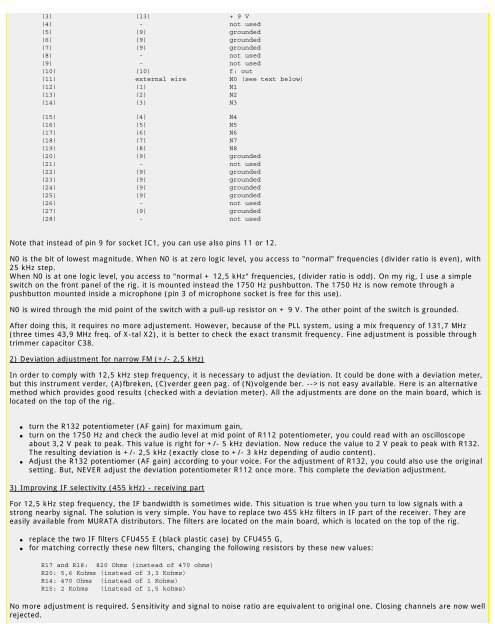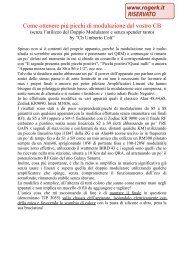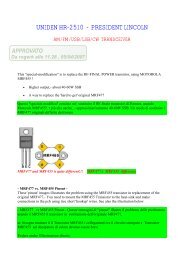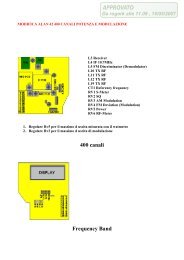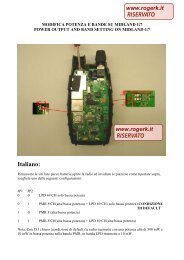Modifications for the ICOM - RogerK
Modifications for the ICOM - RogerK
Modifications for the ICOM - RogerK
- No tags were found...
Create successful ePaper yourself
Turn your PDF publications into a flip-book with our unique Google optimized e-Paper software.
(3) (13) + 9 V(4) - not used(5) (9) grounded(6) (9) grounded(7) (9) grounded(8) - not used(9) - not used(10) (10) f: out(11) external wire N0 (see text below)(12) (1) N1(13) (2) N2(14) (3) N3(15) (4) N4(16) (5) N5(17) (6) N6(18) (7) N7(19) (8) N8(20) (9) grounded(21) - not used(22) (9) grounded(23) (9) grounded(24) (9) grounded(25) (9) grounded(26) - not used(27) (9) grounded(28) - not usedNote that instead of pin 9 <strong>for</strong> socket IC1, you can use also pins 11 or 12.N0 is <strong>the</strong> bit of lowest magnitude. When N0 is at zero logic level, you access to "normal" frequencies (divider ratio is even), with25 kHz step.When N0 is at one logic level, you access to "normal + 12,5 kHz" frequencies, (divider ratio is odd). On my rig, I use a simpleswitch on <strong>the</strong> front panel of <strong>the</strong> rig. it is mounted instead <strong>the</strong> 1750 Hz pushbutton. The 1750 Hz is now remote through apushbutton mounted inside a microphone (pin 3 of microphone socket is free <strong>for</strong> this use).N0 is wired through <strong>the</strong> mid point of <strong>the</strong> switch with a pull-up resistor on + 9 V. The o<strong>the</strong>r point of <strong>the</strong> switch is grounded.After doing this, it requires no more adjustement. However, because of <strong>the</strong> PLL system, using a mix frequency of 131,7 MHz(three times 43,9 MHz freq. of X-tal X2), it is better to check <strong>the</strong> exact transmit frequency. Fine adjustment is possible throughtrimmer capacitor C38.2) Deviation adjustment <strong>for</strong> narrow FM (+/- 2,5 kHz)In order to comply with 12,5 kHz step frequency, it is necessary to adjust <strong>the</strong> deviation. It could be done with a deviation meter,but this instrument verder, (A)fbreken, (C)verder geen pag. of (N)volgende ber. -->is not easy available. Here is an alternativemethod which provides good results (checked with a deviation meter). All <strong>the</strong> adjustments are done on <strong>the</strong> main board, which islocated on <strong>the</strong> top of <strong>the</strong> rig.●●●turn <strong>the</strong> R132 potentiometer (AF gain) <strong>for</strong> maximum gain,turn on <strong>the</strong> 1750 Hz and check <strong>the</strong> audio level at mid point of R112 potentiometer, you could read with an oscilloscopeabout 3,2 V peak to peak. This value is right <strong>for</strong> +/- 5 kHz deviation. Now reduce <strong>the</strong> value to 2 V peak to peak with R132.The resulting deviation is +/- 2,5 kHz (exactly close to +/- 3 kHz depending of audio content).Adjust <strong>the</strong> R132 potentiomer (AF gain) according to your voice. For <strong>the</strong> adjustment of R132, you could also use <strong>the</strong> originalsetting. But, NEVER adjust <strong>the</strong> deviation potentiometer R112 once more. This complete <strong>the</strong> deviation adjustment.3) Improving IF selectivity (455 kHz) - receiving partFor 12,5 kHz step frequency, <strong>the</strong> IF bandwidth is sometimes wide. This situation is true when you turn to low signals with astrong nearby signal. The solution is very simple. You have to replace two 455 kHz filters in IF part of <strong>the</strong> receiver. They areeasily available from MURATA distributors. The filters are located on <strong>the</strong> main board, which is located on <strong>the</strong> top of <strong>the</strong> rig.● replace <strong>the</strong> two IF filters CFU455 E (black plastic case) by CFU455 G,● <strong>for</strong> matching correctly <strong>the</strong>se new filters, changing <strong>the</strong> following resistors by <strong>the</strong>se new values:R17 and R18: 820 Ohms (instead of 470 ohms)R20: 5,6 Kohms (instead of 3,3 Kohms)R14: 470 Ohms (instead of 1 Kohms)R15: 2 Kohms (instead of 1,5 kohms)No more adjustment is required. Sensitivity and signal to noise ratio are equivalent to original one. Closing channels are now wellrejected.


